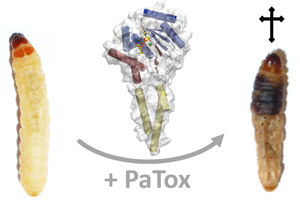Only lethal if sugar is present
Immunising cells against the biological weapon ricin
Advertisement
The plant toxin ricin is one of the most poisonous naturally occurring proteins, making it an extremely dangerous bioweapon. Ricin attacks have made the headlines a number of times over the years, including the spectacular “umbrella murder” in London in the 1970s, or more recently the ricin letters addressed to Barack Obama in 2014. As there is no antidote, it is all the more fortunate that the letters were intercepted.
Ricin takes effect once it enters an organism. It destroys cells’ “protein machines”, known as ribosomes, rendering one of the fundamental processes required for life inactive. Even minute doses can kill within 36-72 hours. The plant that produces the lethal poison, Ricinus communis, is also found in some front gardens and parks. Castor oil extracted from the plant’s seeds – the soluble poison comes from the seed coat – has medical and industrial uses. Scientists have been searching for an effective ricin antidote for decades. However, cytotoxins like ricin also provide important insights into the molecular characteristics of cells, such as the contact points which a poison uses to enter cells and how it makes its way to the part of the cell where it obstructs processes that are essential for life. There is also the question of how cells can protect themselves.

Jasmin Taubenschmid, PhD student at IMBA and first author of the study with a ricin plant
(c)privat
Ricin requires access code containing sugar
IMBA researchers have now discovered that sugar is a key factor. The researchers identified two genes that make ricin so lethal. Fut9 and Slc35c1 regulate metabolism of a particular sugar in cells, namely an essential monosaccharide called fucose – not to be confused with fructose or fruit sugar. It attaches to proteins and is subsequently able to change their form and function. Because fucose also attaches to proteins in the cell wall, it plays an important role in communication and transport between cells and their surroundings. As reported in Cell Research, both Fut9 and Slc35c1 are responsible for ricin’s toxic effect because they give the poison access to cells’ transport systems, enabling it to reach the ribosomes, which it ultimately destroys.
“Inhibiting these genes, for instance by means of a synthesised molecule, obstructs the transport of ricin into the cells and stops it reaching those parts where it can unleash such significant damage. This is because the poison requires a typical sugar signature on the cell wall to which it can attach,” explained Jasmin Taubenschmid, a PhD student in the IMBA team headed by Josef Penninger. Taubenschmid and protein researcher Johannes Stadlmann are the lead authors of the recently published study. The research also delivers new insights into the interplay between proteins and sugar, which plays a part in various fundamental biological processes. “Previous research looked at proteins and sugar separately. But it turns out that the interaction between them is particularly fascinating, and this has generated an entirely new level of information,” Stadlmann pointed out.
Extremely rare genetic defect the key to ricin therapy?
A special partnership with the University of Münster and Heidelberg University shed light on the mechanism through which the poison has an effect. University hospital departments provided the IMBA research team with cell samples from a patient who was unable to metabolise fucose due to an extremely rare genetic defect. He was one of only a handful of people who might have survived an attempted umbrella murder. This is because ricin is not toxic without this particular sugar. “Research into rare diseases often produces astonishing findings which are useful to a large number of people,” commented IMBA Scientific Director Josef Penninger. In this particular case, research on the very rare inability to metabolise fucose – only three cases have been identified worldwide – contributed significantly to the idea of developing a preventive therapy against ricin poisoning.
Original publication
Stadlmann, Taubenschmid et al.; “A vital sugar code for ricin toxicity”; Cell Research; 2017
























































